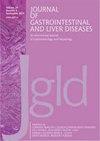Clinical, Endoscopic, and Histopathologic Observations in Gastrointestinal Amyloidosis
IF 2
4区 医学
Q3 GASTROENTEROLOGY & HEPATOLOGY
引用次数: 0
Abstract
Background and Aims: Amyloidosis is a group of systemic disorders caused by extracellular deposition of misfolded serum proteins. Gastrointestinal (GI) involvement is associated with a higher risk of GI bleeding, especially if mucosal lesions are present. Our study aims to evaluate the frequency of GI manifestations in patients with amyloidosis, to clinically characterize these patients and to describe the endoscopic and histopathologic findings in GI amyloidosis. Methods: A retrospective, single-center study of all patients admitted with amyloidosis and GI manifestations was conducted at a German University Hospital between July 2003 and June 2023. Clinical, endoscopic, and histopathological data was retrieved from medical records. Results: Between July 2003 and June 2023, 63 patients with different types of amyloidosis were included into the study. Twenty-three (36,5%) were diagnosed with GI involvement of amyloidosis (60.9% male, median age 62 ± 18.28 years). The distribution of the types of amyloidosis were amyloid light chain (AL) at 52.5%, transthyretin (ATTR) at 21.7%, amyloid A (AA) at 13.0%, and unknown at 18%. Initial GI symptoms were present in 78.3% of the patients and included mainly diarrhea (34.8%), and abdominal pain (30.4%) Affected GI organs were primarily the colon (60,8%) and the stomach (39.1%). Endoscopic findings were ulcerations (47.8%), mucosal inflammation (43.5%), polyps (26.1%), erosions (13.0%), vascular malformation, polypoid protrusion, submucosal hematoma, erythema, metaplasia, and diverticulum. Histopathological findings included vascular wall thickening, (peri-)vascular and interstitial amyloid deposition. Gastrointestinal bleeding occurred in 39.1% of the patients. The mortality rate 5 years after diagnosis was 47.8%. Conclusions: Gastrointestinal amyloidosis can present with multiple symptoms and endoscopic findings, rendering diagnosis a challenge. Of clinical relevance, GI bleeding was a frequent event in our patient cohort. Therefore, clinicians must be aware of GI bleeding as a manifestation of amyloidosis and definite diagnosis should be achieved based on biopsy results.胃肠道淀粉样变性的临床、内窥镜和组织病理学观察
背景和目的:淀粉样变性是由错误折叠的血清蛋白在细胞外沉积引起的一组全身性疾病。胃肠道(GI)受累与较高的胃肠道出血风险有关,尤其是在出现粘膜病变的情况下。我们的研究旨在评估淀粉样变性患者出现消化道表现的频率,了解这些患者的临床特征,并描述消化道淀粉样变性的内镜和组织病理学发现。研究方法2003年7月至2023年6月期间,一家德国大学医院对所有因淀粉样变性和消化道表现而入院的患者进行了一项回顾性单中心研究。研究人员从病历中提取了临床、内镜和组织病理学数据。结果:2003年7月至2023年6月期间,63名不同类型的淀粉样变性患者被纳入研究。其中 23 人(36.5%)被确诊为消化道受累的淀粉样变性(60.9% 为男性,中位年龄为 62 ± 18.28 岁)。淀粉样变性的类型分布为:淀粉样轻链(AL)52.5%,转甲状腺素(ATTR)21.7%,淀粉样A(AA)13.0%,未知18%。78.3%的患者最初出现消化道症状,主要包括腹泻(34.8%)和腹痛(30.4%),受影响的消化道器官主要是结肠(60.8%)和胃(39.1%)。内镜检查结果为溃疡(47.8%)、粘膜炎症(43.5%)、息肉(26.1%)、糜烂(13.0%)、血管畸形、息肉样突起、粘膜下血肿、红斑、变性和憩室。组织病理学检查结果包括血管壁增厚、(血管周围)和间质淀粉样沉积。39.1%的患者会出现消化道出血。确诊后 5 年的死亡率为 47.8%。结论是胃肠道淀粉样变性可表现为多种症状和内窥镜检查结果,因此诊断是一项挑战。与临床相关的是,消化道出血是本组患者的常见病。因此,临床医生必须意识到消化道出血是淀粉样变性的一种表现,并应根据活检结果做出明确诊断。
本文章由计算机程序翻译,如有差异,请以英文原文为准。
求助全文
约1分钟内获得全文
求助全文
来源期刊
CiteScore
3.20
自引率
0.00%
发文量
61
审稿时长
6-12 weeks
期刊介绍:
The Journal of Gastrointestinal and Liver Diseases (formerly Romanian Journal of Gastroenterology) publishes papers reporting original clinical and scientific research, which are of a high standard and which contribute to the advancement of knowledge in the field of gastroenterology and hepatology. The field comprises prevention, diagnosis and management of gastrointestinal and hepatobiliary disorders, as well as related molecular genetics, pathophysiology, and epidemiology. The journal also publishes reviews, editorials and short communications on those specific topics. Case reports will be accepted if of great interest and well investigated.

 求助内容:
求助内容: 应助结果提醒方式:
应助结果提醒方式:


